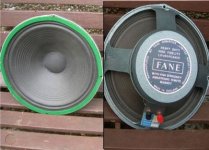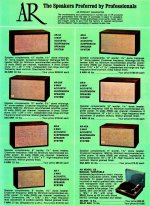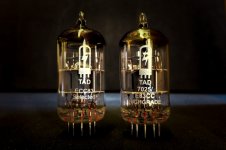That's precisely what would be needed to fully explain the meaning of 'adiabatic'! 🙂
The air in a sealed enclosure obeys the 'Gas Laws' Gas laws - Wikipedia. Only in an isothermal setting does the product of pressure and volume remain constant, allowing the compression and expansion of the air to remain linear. In an adiabatic setting, the compression and expansion is non-linear
Nobody talks too much about this. I wonder, at what point does this become a significant factor? I've thought about it, but never explored it.
Unfortunately, jimmyjoe wants it kept simple.
Some simple speakers work pretty well. People have built OK speakers before, without using a bunch of fancy pants math. But that depends on serendipity.
P.S. The generation of heat in the voice coil is a separate issue from the generation of heat in the air inside the enclosure due to compression and expansion.
Yup. I think our friend has that concept clear.
I think, Fast Eddie, that he means that I want the EXPLANATION kept simple. And he's correct; I do want the explanation kept simple. That's why I said that I shot myself in the foot; this subject is not easily distilled.
The matter of keeping the speaker system design simple is a separate issue.
Again ...... thank you, everyone. jj
The matter of keeping the speaker system design simple is a separate issue.
Again ...... thank you, everyone. jj
Transferring the heat from where to where? If you want to transfer the heat of the air inside the box to the air outside the box, a normal heatsink would be very inefficient, as they rely on efficient heat transfer from a (usually) metal object, like a transistor or speaker magnet to a metal heatsink. Which then has to overcome the inefficient heat transfer from metal to air. Hence lots of fins. If it's from a driver frame or magnet, that then transfers (hopefully) the heat into the air. Which is often inside the speaker box!If these statements are true, wouldn't a heat sink be more efficient at transferring heat than the absorbent? Just integrate it into the box. Yes? No? jj
That's fairly simple, as it's about all I can manage! 😀
It's all about linearity I suppose, Eddie. You'll have heard talk of Edgar Villchur of Acoustic Research who designed the 'air suspension' woofer, which had a very high suspension compliance. Mounted in a small sealed enclosure, most of the restoring force came from the spring of the trapped air and not from the spring of the mechanical suspension as it does in a conventional woofer.Nobody talks too much about this. I wonder, at what point does this become a significant factor? I've thought about it, but never explored it.
The trapped air provided an (almost) linear spring for the woofer's cone. This allowed the cone to to move back and forth large distances in a linear fashion. By contrast, mechanical springs produce larger restoring forces at larger excursions which leads to non-linearity.
The disadvantage of 'acoustic suspension' was very low sensitivity.
Oh! And, of course the enclosure was filled with absorbent material to provide (nearly) isothermal operation.
The trapped air provided an (almost) linear spring for the woofer's cone. This allowed the cone to to move back and forth large distances in a linear fashion. By contrast, mechanical springs produce larger restoring forces at larger excursions which leads to non-linearity.
I'm old enough to remember when AR introduced their new, compact loudspeakers. I was already DIYing and the DIY community was prone to building very large, efficient speakers (present company included). This was something new. The idea of the enclosure providing most of the mechanical resistance was new and interesting. And your explanation of (almost) linear forces makes sense. I've thought about it but never explored it.
The disadvantage of 'acoustic suspension' was very low sensitivity.
True, but power is cheap nowadays. Back when AR introduced their loudspeakers, 40 watts/channel was a lot for a hi-fi amplifier.
Air suspension drivers are way better today. Old AR speakers still have a market, as well as replacement parts for them. I don't think they're good by today's standards, but they represent an important part of hi-fi history.
I think, Fast Eddie, that he means that I want the EXPLANATION kept simple.
Yeah, I realize that.
You've asked some good questions, and I hope the answers are helping you. Speaker design is a deep topic, rife with popular misconceptions and misunderstandings, and it can be hard to get started in the right direction.
Cheers! My DIY speaker building certainly started in the era of The Beatles! 🙂I'm old enough to remember when AR introduced their new, compact loudspeakers. I was already DIYing and the DIY community was prone to building very large, efficient speakers (present company included).
My first speaker was a 12" Fane 122/10 mounted in a 5 cubic foot reflex enclosure and powered with a 10W EL84 PP amp. Magnificent mono, and my first encounter with some serious bass extension!
For clarity, I should add to the discussion that ordinary sealed box speakers are not the same as acoustic suspension speakers.
The difference is comprehensively explained in this article: Sealed is Not Acoustic Suspension in Loudspeakers | Audioholics
Attachments
" .... The difference is comprehensively explained in this article: Sealed is Not Acoustic Suspension in Loudspeakers | Audioholics .... "
Again, great information, and clearly presented! That was a real eye-opener for me. jj
Again, great information, and clearly presented! That was a real eye-opener for me. jj
Since I opened a can of worms with my last question, let's try a different tack for our next subject. This is just an idle question, but something about which I've wondered for a looooong time.
When I was a kid, everything was tubes (valves). I remember the tube tester displayed prominently at the local drugstore (!). My parents had an old Philco cabinet radio, and I remember looking inside the back one day, out of nothing more than that good ol' idle curiosity, and seeing a tube glowing. That tube was original. It had never been replaced, and it was still giving good service, probably 30+ years into its life. I remember my Dad going downtown to get a new tube for some or other apparatus, and grumbling because the tube "only lasted 5 years".
Why can't modern tube gear be built that gives a good many long years of serviceable life? Actually, I suppose that I shouldn't use the word "can't". I know it CAN. I suppose I should ask the question, "Why isn't it?" Greed? Fashion? Poor contemporary quality? Higher contemporary standards?
Why? jj
When I was a kid, everything was tubes (valves). I remember the tube tester displayed prominently at the local drugstore (!). My parents had an old Philco cabinet radio, and I remember looking inside the back one day, out of nothing more than that good ol' idle curiosity, and seeing a tube glowing. That tube was original. It had never been replaced, and it was still giving good service, probably 30+ years into its life. I remember my Dad going downtown to get a new tube for some or other apparatus, and grumbling because the tube "only lasted 5 years".
Why can't modern tube gear be built that gives a good many long years of serviceable life? Actually, I suppose that I shouldn't use the word "can't". I know it CAN. I suppose I should ask the question, "Why isn't it?" Greed? Fashion? Poor contemporary quality? Higher contemporary standards?
Why? jj
Depends on the valve function. Preamp valves which operate at low current can last a lifetime.
Power valves which operate at high current may only last for some hundreds of hours before their performance deteriorates.
Power valves which operate at high current may only last for some hundreds of hours before their performance deteriorates.
" .... Power valves which operate at high current may only last for some hundreds of hours before their performance deteriorates. ... "
You used the word "may", and that's true. But I would suspect that it doesn't NEED to be true. Somewhere (old man's memory) I read about a pair of Altec Lansing speakers being moved in a house. Behind the speakers, all dusty and cobwebbed, were two McIntosh tube amplifiers. Everything still worked fine. I got the impression that the amps had been there for quite a few years ..... perhaps since the original installation.
My point is this: I understand the current state of affairs. I also understand that it doesn't have to be this way. So why on earth IS IT this way? Why aren't there tube amps on the market that last 10 to 20 years between re-tubing? I had posited several possible reasons. Perhaps it's not one, but ALL of them.
And perhaps the answer isn't even worth thinking about ....... jj
You used the word "may", and that's true. But I would suspect that it doesn't NEED to be true. Somewhere (old man's memory) I read about a pair of Altec Lansing speakers being moved in a house. Behind the speakers, all dusty and cobwebbed, were two McIntosh tube amplifiers. Everything still worked fine. I got the impression that the amps had been there for quite a few years ..... perhaps since the original installation.
My point is this: I understand the current state of affairs. I also understand that it doesn't have to be this way. So why on earth IS IT this way? Why aren't there tube amps on the market that last 10 to 20 years between re-tubing? I had posited several possible reasons. Perhaps it's not one, but ALL of them.
And perhaps the answer isn't even worth thinking about ....... jj
Good evening. Back again. Another question:
Has anyone tried this setup? If so, how well did it work out?
https://www.updatemydynaco.com/HistoricDocuments/DynacoCenterChannel.pdf
Thanks. jj
Yes. It works particularly well in a car, where you would often hear only one channel due to the offset seating arrangement. The centre channel makes the sound much wider. It was a good trick when upgrading from mono AM to stereo FM radios. Just use the original 6x9 dash-mounted oval speaker as the centre channel.
I haven't tried the centre channel circuit. Like ABD, I also played with the Hafler system which sent a sum signal to a rear speaker or speakers to simulate a surround sound effect. Fun, but ultimately unsatisfying. It was the poor man's Quadraphonics and commercial Hafler adaptors were produced to cash in on the Quadraphonics vibe. Details here: http://www.audiosignal.co.uk/Resources/A_year_of_surround_sound_A4.pdf
It really needed a delay unit to work properly. I built one with a bucket brigade device.
I don't have 3 equal speakers, and it would be expensive to get 3 equal speakers (even cheap ones), but it looks like that is what I'll have to do. I just would have liked some user testimony before I took the plunge.
I guess there aren't as many old-timers here as what I had hoped for. 🙁 jj
So long as the efficiency is similar they don't need to be identical.
" .... What's another word for thesaurus? ... " I'm groaning and laughing at the same time!
" .... So long as the efficiency is similar they don't need to be identical .... "
I suspect you mean "sensitivity" rather than "efficiency", but I think I understand what you're saying. Oddly enough, one of the old farts around here who dealt with the problems of the original Hafler system said that his solution to the problems inherent in the center speaker (his words) was to use a center speaker at least 3 dB less sensitive than the left and right speakers. He describes the center speaker as a "thug" regarding its overall contribution to the sound field.
Other people with whom I've spoken had other opinions. And so it goes.
BTW ... I like your sig, haiqu. jj
" .... So long as the efficiency is similar they don't need to be identical .... "
I suspect you mean "sensitivity" rather than "efficiency", but I think I understand what you're saying. Oddly enough, one of the old farts around here who dealt with the problems of the original Hafler system said that his solution to the problems inherent in the center speaker (his words) was to use a center speaker at least 3 dB less sensitive than the left and right speakers. He describes the center speaker as a "thug" regarding its overall contribution to the sound field.
Other people with whom I've spoken had other opinions. And so it goes.
BTW ... I like your sig, haiqu. jj
Asking how long a set of valves will last is the same as asking “How long does a set of car tyres last?”Behind the speakers, all dusty and cobwebbed, were two McIntosh tube amplifiers. Everything still worked fine. I got the impression that the amps had been there for quite a few years ..... perhaps since the original installation.
Answer:
- The rate at which tyres wear out depends on the way you drive and how often you drive.
- The rate at which valves wear out is determined by how hard (loud) they have been played and how many hours they have been on.
The valve amp I am currently using in my 'man shed' was purchased new by me in 1969 and is still operating effectively with its original set of Mullard and Brimar valves.Why aren't there tube amps on the market that last 10 to 20 years between re-tubing?
However, the amp has not been in continuous use for all of those 51 years, nor has it been continuously played at high volumes.
Guitar amps are a particularly harsh physical and electrical environment for valves, but this excellent article from Hughes & Kettner give a much rosier picture for the life-span of power valves that I did: When could, would and should you replace tubes? - Hughes & Kettner BLOG
The article suggests a life of 10,000 hours is not an unrealistic prospect and this represents a useful playing for fun and gigging life of around 33 years!
Military spec valves can last 100,000 hours i.e. 10 times longer than their civilian equivalents. The military equivalent of the ECC83 is the E83CC.
Attachments
Thanks for that. Although I should have read it before now! 🙄The difference is comprehensively explained in this article: Sealed is Not Acoustic Suspension in Loudspeakers | Audioholics
Valve life; my new power amp uses 5687s as drivers, and I would expect them to last several years. Like most small signal valves. The power valves are GM70s; quoted life expectancy, 1000hrs. I will be a ordering a spare pair shortly.
Power valves have a much harder life than small signal valves (usually) so they "wear out" faster. Rather annoying, as they usually cost more! The GM70 is quite cheap, fortunately, unless you want the copper anode version!
Power valves have a much harder life than small signal valves (usually) so they "wear out" faster. Rather annoying, as they usually cost more! The GM70 is quite cheap, fortunately, unless you want the copper anode version!
- Home
- Member Areas
- The Lounge
- different audio forum


